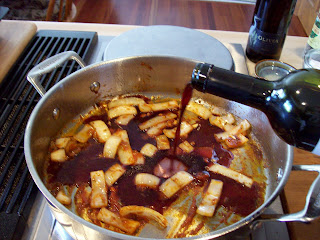Lasagna for Dinner
Once in a while I feel the need for some good lasagna.
Friday was just such a day.
I don't often make this dish
as it is a rather labor-intensive dish involving
several steps and more than a few dirty pots and pans.

The first order of business was to make the sauce.
Now, don't get me wrong;
if you have a favorite jarred pasta sauce,
you may certainly use that.
This time I wanted to make my own sauce.
My assembled ingredients are:
1 can (15 oz.) petite diced tomatoes
1 can (15 oz.) tomato sauce
1 can (6 oz.) tomato paste
(hush, they are typically the same herbs
used in many Northern Italian herb blends)
1/2 carrot, grated
1 clove garlic, grated
1/4 cup onion, minced
salt, to taste
sugar, to taste
Not pictured:
olive oil
Italian red wine
Did you notice Minx watching from the table?
Don't worry, he wasn't near any food.
He just wanted to see what was going on in the kitchen.

I sauteed the onion and carrot in a bit of olive oil until translucent,
before adding the garlic and the can of tomato paste.

The diced tomatoes and tomato sauce were added.

I then decided to add about 1/4 cup of a dry Italian red wine.

The Herbes de Provence were stirred in
before I added salt and sugar to taste.
I allowed this to simmer for about an hour.

It was time to move on to the meats for the dish.
I had planned on adding one pound of ground beef
along with a couple of my
homemade pork sausage patties.
Then I saw Rosie Hawthorne's post on lasagna in her blog,
Kitchens are Monkey Business,
so I decided to add the two slices of prosciutto (chopped)
that were left from another dish.
The meats were sauteed until browned
and the fat was drained.

The ingredients for the Ricotta mixture were assembled.
Here I have the Ricotta,
salt,
Herbes de Provence
and a couple of egg yolks
(left over from making beef consomme)
I also followed Rosie Hawthorne's advice and added some salt to the Ricotta cheese mixture.

That's ready.
I also grated one pound of mozzarella cheese
and about a cup of Parmigiano-Reggiano cheese.

After cooking the store-bought pasta*,
I began assembly.
First a layer of tomato sauce,
then the pasta.
Ricotta,
some of the grated mozzarella cheese.
Then more pasta,
sauce,
meat,
pasta,
cheeses (including the Parigiano-Reggiano),
etc. until all ingredients are used.
*I'm no Rosie Hawthorne. I didn't make my own pasta for this dish.

Assembled.
And after dirtying
3 pots and pans and lids,
3 bowls,
1 cutting mat,
2 graters,
1 baking dish,
1 knife,
1 peeler
and several other utensils.
I told you this is labor-intensive
as well as a labor of love.
And there's a reason I only make this once or twice a year.

I baked this at 350 degrees for one hour.
The pan was covered with foil for the first half-hour
(thanks, Rosie Hawthorne, for the tip about using toothpicks.
The Foodie Daughter wondered why
I had never thought of doing so.).
Allow the dish to rest for at least 15 minutes
before slicing and serving.

A fresh salad with Romaine lettuce, red onion,
candied pecans
and shaved Parmigiano-Reggiano accompanied the lasagna.
This was good, but I know it will be even better
when I reheat it for Sunday's dinner.

So good and it was definitely worth all the trouble.
 The diced tomatoes and tomato sauce were added.
The diced tomatoes and tomato sauce were added. I then decided to add about 1/4 cup of a dry Italian red wine.
I then decided to add about 1/4 cup of a dry Italian red wine.
 It was time to move on to the meats for the dish.
It was time to move on to the meats for the dish. The ingredients for the Ricotta mixture were assembled.
The ingredients for the Ricotta mixture were assembled. That's ready.
That's ready.































































